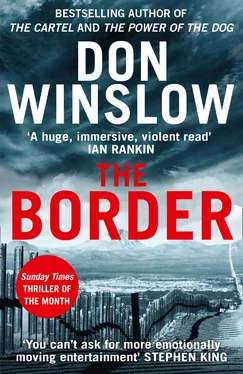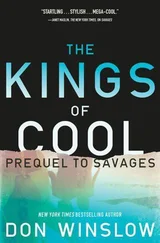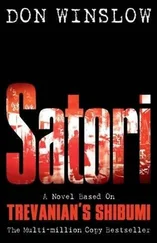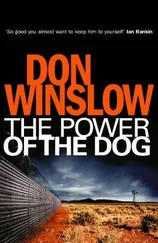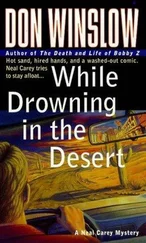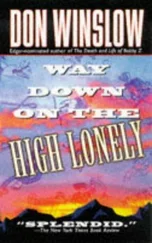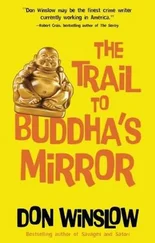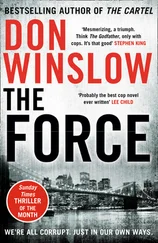“Call it what you want,” Mullen says. “It’s saving lives. The revolving door of bust-and-convict doesn’t. I arrest addicts, they shoot up in jail. I take dealers out, new ones take their place. I seize heroin, more comes in. Bobby, let’s head up to Inwood, show this man what he needs to see.”
“Jersey or Brooklyn?” Cirello asks.
“Take the Verrazano,” Mullen says. He looks at Keller. “I don’t like going out of my jurisdiction.”
They take Route 278 into the Bay Ridge section of Brooklyn, then Sunset Park and Carroll Gardens. Mullen says, “This used to be called Red Hook, but Carroll Gardens sounds better for real estate. You’re not a New York guy, are you?”
“San Diego.”
“Beautiful there,” Mullen says. “Great weather, right?”
“I haven’t been there much the past few years,” Keller says. “Mostly El Paso and Mexico. Now DC.”
They cross the Brooklyn Bridge into lower Manhattan, over to the West Side Highway almost all the way up the island until they turn off at Dyckman Street, then take a left and go up Broadway.
“Where are we?” Keller asks.
“Fort Tryon Park, Inwood area,” Mullen says. “The northernmost tip of Manhattan, and heroin central.”
Keller looks around at the well-tended redbrick apartment complexes. Parks, ballfields, nannies pushing babies in strollers. “Doesn’t look like it.”
“Exactly,” Mullen says. “There aren’t a lot of users up here, but what you have here in Inwood and Washington Heights, just downtown from here, are heroin mills. This is where your Mexicans bring the shit in, sell it to wholesalers who cut it up, put it into dime bags and ship it out. Sort of an Amazon fulfillment center.”
“Why here?”
Location, location, location, Mullen explains. Easy access to Route 9, right up to the little towns on the Hudson that are getting hammered with the shit. A short hop to 95 and the Bronx, or out to Long Island or up to New England. Harlem is just down Broadway, and you’re close to the West Side Highway and the FDR to go to the boroughs.
“If you were UPS or FedEx,” Mullen says, “and wanted to serve the Northeast Corridor, this is where you’d be. You can get in your car, be on the Jersey Turnpike or the Garden State in minutes and you’re on your way to Newark, Camden, Wilmington, Philly, Baltimore, Washington. If you’re moving less weight, you put it in a backpack, you take the One or the Two train to Penn Station and get on the Acela. Go south to the towns I just mentioned or north to Providence or Boston. No one is going to stop you, no one’s going to search your bag, and they have Wi-Fi on the train, you can catch up on Narcos .
“Your people are onto this, too. We’ve busted mills here … fifteen pounds, twenty, thirty-five, millions in cash … but the narcos write it off as the cost of doing business, and the shit keeps coming.”
“You feel like you’re trying to sweep back the ocean,” Keller says.
“Something like that.”
“Are you getting what you need from my agency?” Keller asks.
“In the short term?” Mullen says. “Pretty much. Look, there’s always the tension between feds and local police, let’s not kid ourselves. Some of your people are afraid to share information with us, either because they want the busts for themselves or they think all local cops are dirty. My people will play hide-the-ball with your guys because they want the busts and they don’t want the feds tromping over their turf and jacking it up.”
Coordination is tricky, Keller knows, even when there’s the best of intent, which isn’t always the case. It’s too easy for different agencies to run across each other’s informants or protected witnesses, jam up or cut short a promising investigation, even get informants killed. And he knows DEA can be high-handed with local police forces, telling them to stay away from investigations, just as he knows the local guys are too often more than willing to freeze his people out of valuable intelligence.
Professional jealousy is a real problem. Everyone wants to make busts themselves because busts are the route to promotions. And good publicity—everyone wants to stand in front of that table loaded with drugs, guns, and money and get their picture taken. It’s become a cliché but not a harmless one, Keller thinks, because it gives the impression that we’re winning a war we’re not winning.
The drugs on the table are like photos of dead Vietcong.
“But for the most part,” Mullen is saying, “I think we’re working pretty well together. It could always be better, of course.”
Which is Mullen opening the door, Keller thinks. Asking the question—what are you really doing here?
“Why don’t you and I talk away from the kids,” Keller says.
“You ever been to the Cloisters?”
Keller and Mullen walk along the pillared arches of the Cuxa Cloisters in the park not far from Inwood. The structure was once part of the Benedictine Abbey of St. Michel in the French Pyrenees, was moved to New York in 1907 and now surrounds a central garden.
Keller knows that Mullen is making a statement by coming here. And, sure enough, Mullen says, “I heard you liked monasteries.”
“I lived in one for a while.”
“Yeah, that’s what I heard,” Mullen says. “In New Mexico, right? What was that like?”
“Quiet.”
“They said you were in charge of, what, the beehives or something?” Mullen asks.
“The monastery sold honey,” Keller says. “What else do you want to know, Brian?”
Because if Mullen has doubts about him, it’s better to know now.
“Why did you leave it?” Mullen asks.
“Because they let Adán Barrera out of prison.”
“And you wanted to put him back in,” Mullen says.
“Something like that.”
“I like it here,” Mullen says. “I like to come here, walk around and think. It gets me away from all the shit. I’m not sure I like the modern world, Art.”
“Me neither,” Keller says. “But it’s the one we have.”
“Hey, we’re at the chapel, you want to go in?” Mullen asks. “I mean, if we’re going to have a come-to-Jesus talk, we might as well come to Jesus.”
They go through the heavy oak doors, which are flanked by carvings of leaping animals. The large room is dominated by an apse at the end with a hanging crucifix. The side wall contains frescoes honoring the Virgin Mary.
“They moved this here from Spain,” Mullen says. “Beautiful, huh?”
“It is.”
“Why are you really here?” Mullen asks. “I know it’s not for me to give you a tour and show you things you already know.”
“You talked about triage,” Keller says. “Short-term and long-term solutions. I want you to know my long-term intentions. I’m going to move DEA onto a new course, more in the direction of what you were talking about earlier. Away from the revolving door of arrest and incarceration, more into rehabilitation. I want us to back local initiatives with federal power and remove federal obstacles.”
“Can you?” Mullen says. “Your people aren’t going to like it.”
Keller knows what Mullen isn’t saying but what he’s thinking, that DEA has a vested interest in keeping the drug war going—its own existence.
“I don’t know,” Keller says. “But I’m going to try. If I’m going to succeed, I’ll need support from police forces like NYPD.”
“And the short term?”
“Until we change the baseline,” Keller says, “we have to do everything we can to slow the flow of heroin.”
“No argument from me.”
“I’ve come to the conclusion that I can’t do much in Mexico,” Keller says. “They’re too protected. If I’m going to attack the problem, it has to be here in New York, which has become the heroin hub.”
Читать дальше
